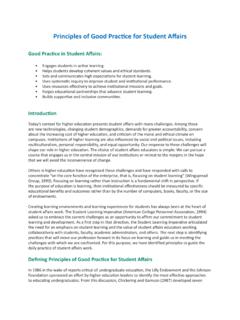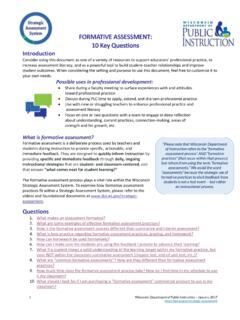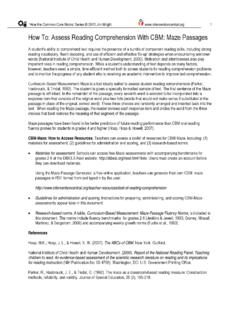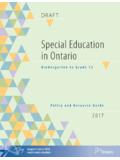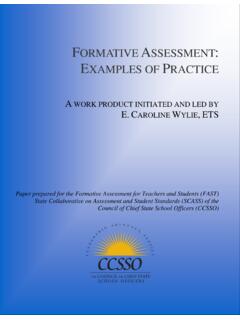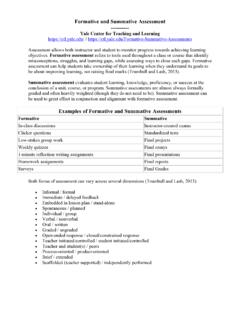Transcription of Professional Competency Areas for Student Affairs Educators
1 Professional Competency Areas for Student Affairs Educators2 Professional Competency Areas for Student Affairs EducatorsProfessional Competencies Task ForceDr. Berenecea Johnson Eanes (Co-chair)Vice President for Student AffairsCalifornia State University-FullertonDr. Patricia A. Perillo (Co-chair)Vice President for Student Affairs and Assistant Professor of Higher EducationVirginia TechDr. Tricia FechterDeputy Executive DirectorACPA-College Student Educators InternationalStephanie A. GordonVice President for Professional DevelopmentNASPA- Student Affairs Administrators in Higher EducationDr. Shaun Harper1 Executive DirectorUniversity of PennsylvaniaDr. Pamela HaviceProfessorClemson UniversityDr. John L. HoffmanChair, Department of Educational LeadershipCalifornia State University, FullertonDr. Quincy Martin, IIIA ssociate Vice President, Student AffairsTriton CollegeDr. Laura OsteenDirector, Center for Leadership and Social ChangeFlorida State UniversityDr.
2 Jason B. PinaVice President for Student AffairsBridgewater State UniversityWill SimpkinsDirector, Center for Career & Professional DevelopmentCUNY John Jay College Criminal JusticeVu T. TranGraduate Research AssociateOhio State University-ColumbusDr. Bridget Turner KellyAssociate ProfessorLoyola University-ChicagoDr. Case WilloughbyVice President for Student Services & Enrollment ManagementButler County Community College 1 Dr. Harper had to withdraw from the task force after participating in preliminary College Student Educators International & NASPA Student Affairs Administrators in Higher Education3 Table of ContentsBackground Information and Changes 4 The Professional Competency Areas for Student Affairs Educators 7 Intersection of Competencies 9 Implications and Applications 10 Overview of the Competency Areas 12 Comprehensive Presentation of the Competency Areas 16 Personal and Ethical Foundations (PPF)
3 16 Values, Philosophy, and History (VPH) 18 assessment , Evaluation, and Research (AER) 20 Law, Policy, and Governance (LPG) 22 Organizational and Human Resource (OHR) 24 Leadership (LEAD) 27 Social Justice and Inclusion (SJI) 30 Student Learning and Development (SLD) 32 Technology (TECH) 33 Advising and Supporting (A/S) 36 References 384 Professional Competency Areas for Student Affairs EducatorsBackground Information and ChangesIn 2009, ACPA College Student Educators International and NASPA Student Affairs Administrators in Higher Education collaborated to establish a common set of Professional Competency Areas for Student Affairs Educators .
4 The Joint Task Force on Professional Competencies and Standards, which consisted of representatives from both associations, analyzed 19 core documents produced by ACPA, NASPA, and the Council for the Advancement of Standards in Higher Education (CAS), and then proposed a framework that included 10 Competency Areas . The memberships of the two associations were invited to comment on preliminary drafts of the proposed document in spring 2010, and then the boards of ACPA and NASPA adopted the Competency document in a joint meeting in July 2010. Among the recommendations included in the final document was a call for periodic review and updates to the Professional competencies. In August 2014, ACPA and NASPA formed the Professional Competencies Task Force to review the Professional competencies and recommend changes as needed. Beginning in October 2014, we the members of this task force began to study the original document and to review scholarly works published over the previous 10 years that aimed to identify Areas of Professional competence in Student Affairs (Burkard, Cole, Ott, & Stoflet, 2005; Hickmott & Bresciani, 2010; Hoffman & Bresciani, 2012; Weiner, Bresciani, Oyler, & Felix, 2011).
5 Central to this work was consideration of applications of the competencies to practice, Professional development, and the preparation of new professionals through graduate study. Additionally, we considered recommendations from ACPA s Digital Task Force and a formal proposal from NASPA s Technology Knowledge Community (Valliere, Endersby, & Brinton, 2013) to add a Competency addressing the use of technology in Student Affairs work. Through several months of bi- weekly , web-based meetings and a single in-person meeting, we generated a preliminary draft of proposed changes. We presented these changes for consideration and feedback to ACPA and NASPA at their annual meetings in March 2015. Later in April 2015, we reached out to several specific constituency groups and utilized ACPA s and NASPA s websites and membership rosters to distribute the proposed changes to the full membership of the two associations for review and feedback.
6 We compiled and analyzed this feedback in May 2015, made final revisions to our proposed changes, and presented them to the boards of ACPA and NASPA for formal adoption in July of ChangesWhereas we made several significant changes, we intentionally preserved most of the work of the 2010 Joint Task Force on Professional Competencies and Standards in this document. We did not eliminate any of the original 10 Competency Areas , though we renamed two Competency Areas , introduced one new Competency Areas , and combined two Areas . What follows is a summary of the most significant justice and inclusion. Our most substantial change was in relation to the Equity, Diversity, and Inclusion Competency from the 2010 document, which we renamed Social Justice and Inclusion. When reviewing the literature, we found studies published since 2010 referred to similar knowledge and skill sets as incorporating diversity into curricular and co-curricular experiences (Weiner et al.)
7 , 2011, p. 88), diversity and social justice (Hoffman & Bresciani, 2012, p. 31), or dedication to social justice (Hickmott & Bresciani, 2010, p. 10) and understanding diversity (p. 8). Each of these suggests a shift from awareness of diversity, as implicit in prior Competency literature ( Lovell & Kosten, 2000) to a more active orientation. In changing the name to Social Justice and Inclusion, we aimed to align this Competency with research, practice, and a commonly utilized definition of social justice as a process and a goal where the goal is full and equal participation of all groups in a society that is mutually shaped to meet their needs (Bell, 2013, p. 21). Though an important concept, diversity can imply a static, non-participatory orientation where the term diverse is associated with members of non-dominant groups. In contrast, we aimed to frame inclusiveness in a manner that does not norm dominant cultures but that recognizes all groups and populations are diverse as related to ACPA College Student Educators International & NASPA Student Affairs Administrators in Higher Education5all other groups and populations.
8 Bell s (2013) definition of social justice further necessitates that social justice include a vision of society in which the distribution of resources is equitable and all members are physically and psychologically safe and secure (p. 21). This definition subsumes the construct of equity as more than a goal, but a precondition of a larger good. In sum, our intent was to integrate the concepts of equity, diversity, and inclusion within the active framework of social In 2010, technology was included as a thread or an essential element of each Competency area (ACPA & NASPA, 2010, p. 5). However, an unintended consequence was that technology was often omitted from practical applications of the competencies. Responding to similar observations, ACPA s Digital Task Force and NASPA s Technology Knowledge Community each submitted recommendations to add technology as a distinct Competency area. We also observed that technology emerged as a distinct Competency in three of the four empirical studies published within the past 10 years that have aimed to identify Professional competencies (Burkard, et al.)
9 , 2005; Hickmott & Bresciani, 2010; Hoffman & Bresciani, 2012). The only study that did not identify technology as a separate Competency (Wiener et al., 2011) was based more narrowly on an analysis of Professional association documents. Additionally, several recent Professional works have noted the importance of integrating technology into the educational work of Student Affairs Educators ( Ahlquist, 2014; Brown, 2013; Junco, 2015; Sabado, 2015).When gathering feedback on a proposed technology Competency , two themes became apparent. First, in order for technology to be a Student Affairs Competency area, we needed to keep its focus on applications to the holistic, developmental work of Student Affairs Educators . Student learning and success spans environments that are both physical and virtual; thus, Student Affairs Educators must proactively engage students within these settings. Second, common connotations of technology construe it largely in terms of hardware, software, and other digital tools.
10 Our focus is broader and inclusive of innovation, meaning that Student Affairs work is dynamic and must use a variety of tools to engage students in learning. Personal and ethical foundations. The 2010 ACPA and NASPA Professional Competencies document included Ethical Professional Practice and Personal Foundations as separate Competency Areas . In our review of scholarly literature, personal foundations only emerged as a distinct Competency area in Hickmott and Bresciani s (2010) analysis of graduate preparation program outcomes. Further, Sriram (2014) questioned the validity of Personal Foundations as its own Competency area. Perhaps of greater importance to us was the conceptual convergence and apparent interdependence of these two Areas . Believing that these two Areas are stronger together, we combined them into a single Competency area, Personal and Ethical and supporting. In changing the name of this Competency area from Advising and Helping to Advising and Supporting, a primary objective was to use language that emphasizes the agency of college students in their development of self-authorship.

